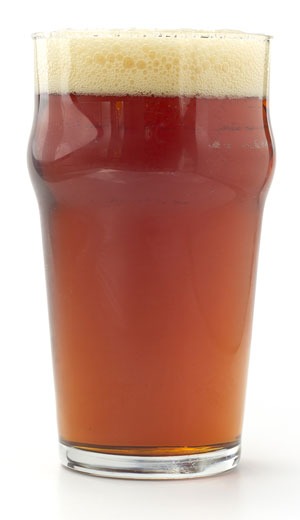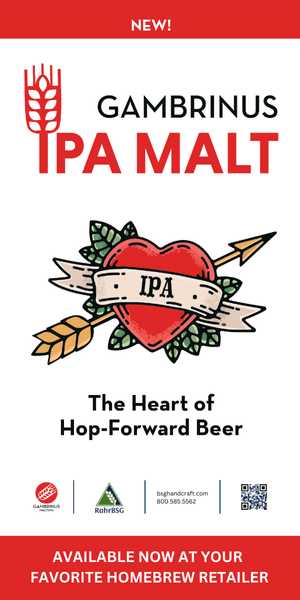Parti-Gyled English Pale Ale and Light Mild
Parti-Gyled English Pale Ale and Light Mild
First gyle (65% efficiency):
(5 gallons/19 L, all-grain)
OG = 1.054 FG = 1.011
IBU = 34 SRM = 13 ABV = 5.8%
Many brewing software apps don’t directly support parti-gyle brewing, so each gyle must be entered as a separate recipe. Create two recipes, but use the same grist for both. For the second batch, change the brewhouse efficiency setting to one half the first recipe (in this case, 65% and 32%). Each recipe has different sugars, hops, and yeast. But read the recipe — these beers are blended before they are fermented! You will likely have to adjust this recipe after brewing to use your system efficiencies based on your sparge techniques.
Ingredients
4 lbs. (1.8 kg) Belgian pale ale malt
4 lbs. (1.8 kg) Golden Promise malt
2 lbs. (908 g) flaked maize
1.6 oz. (45 g) chocolate malt
1 lb. (454 g) amber Belgian candi syrup, D-45
5 AAU East Kent Goldings hops (first wort hop) (1 oz./28 g at 5% alpha acids)
3.7 AAU Challenger hops (60 min.) (0.5 oz./14 g at 7.5% alpha acids)
1 oz. (28 g) East Kent Goldings hops (5 min.)
1 oz. (28 g) Styrian Goldings hops (dry hop)
Wyeast 1968 (London ESB) or White Labs WLP002 (English Ale) yeast
3⁄4 cup corn sugar (for priming)
Second gyle (32% efficiency):
(5 gallons/19 L, all-grain)
OG = 1.027 FG = 1.005
IBU = 13 SRM = 8 ABV = 2.9%
Ingredients
Same grains from first gyle, plus:
0.5 lb. (227 g) Lyle’s Golden Syrup
3 AAU Whitbread Golding Variety (WGV) hops (60 min.) (0.5 oz./14 g at 6% alpha acids)
Wyeast 1335 (British Ale II) yeast
2⁄3 cup corn sugar (if priming)
Step by Step
This recipe uses reverse osmosis (RO) water. Adjust all brewing water to a pH of 5.5 using phosphoric acid. Add 0.5 tsp. of calcium chloride and 0.5 tsp. of calcium sulfate to the mash.
This recipe uses a parti-gyle infusion mash with multiple sparges. Use enough water to have a relatively thin mash (2.5 qts./lb. or 5.2 L/kg) because we will be using the no sparge technique initially. Mash in the malts at 152 °F (67 °C) and hold for 60 minutes. Raise the mash temperature to 169 °F (76 °C) by adding at least 2 gallons (7.5 L) of near-boiling water. Recirculate for 15 minutes.
Put the first wort hops in the kettle. Run off the mash tun slowly without sparging, collecting 6 gallons (23 L) of wort in the kettle. Boil the wort for 60 minutes, adding the hops from the first gyle recipe at the times indicated. Add the candi syrup with 15 minutes left in the boil.
Meanwhile, slowly sparge the mash and collect 6 gallons (23 L) of wort in another kettle. Boil the wort for 60 minutes, adding the hops from the second gyle recipe at the times indicated. Add the candi syrup with 15 minutes left in the boil.
Cool both worts to 66 °F (19 °C). You should have about 5 gallons (19 L) of each wort at the end of each boil. Prepare two fermenters. Blend 4 gallons (15 L) of gyle one and 1 gallon (3.8 L) of gyle two in the first fermenter, yielding 5 gallons (19 L) of 1.049 wort. Blend 1 gallon (3.8 L) of gyle one and 4 gallons (15 L) of gyle two in the second fermenter, yielding 5 gallons (19 L) of 1.032 wort.
Pitch the first yeast into the first fermenter, and ferment the 1.049 beer at 66 °F (19 °C) until complete. Dry hop for 3 days at room temperature.
Pitch the second yeast into the second fermenter, and ferment the 1.032 beer at 70 °F (21 °C) until complete.
Rack the beers, prime and bottle condition in bottles or casks, or keg and force carbonate each beer.
The finished beer from the first fermenter is an English pale ale, OG = 1.049, FG = 1.012, IBU = 30, SRM = 12, ABV = 4.9%.
The finished beer from the second fermenter is an English pale mild, OG = 1.032, FG = 1.005, IBU = 17, SRM = 9, ABV = 3.5%.
Written by Gordon Strong

Create two recipes, but use the same grist for both. For the second batch, change the brewhouse efficiency setting to one half the first recipe (in this case, 65% and 32%). Each recipe has different sugars, hops, and yeast. But read the recipe — these beers are blended before they are fermented! You will likely have to adjust this recipe after brewing to use your system efficiencies based on your sparge techniques.



